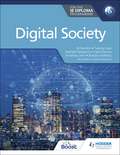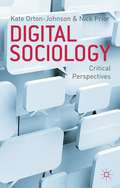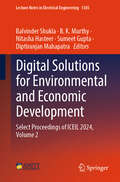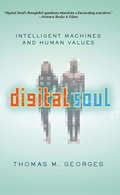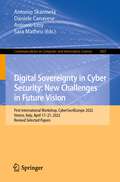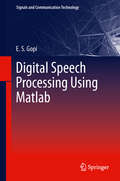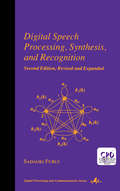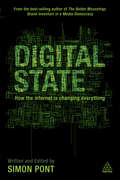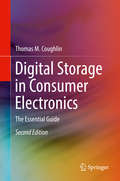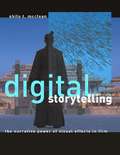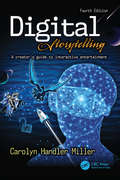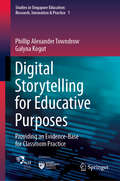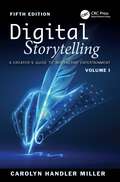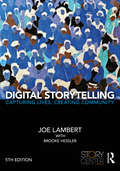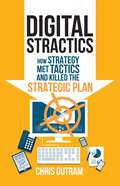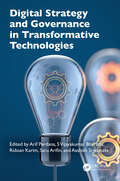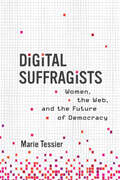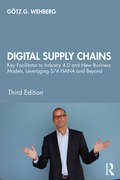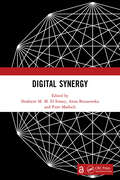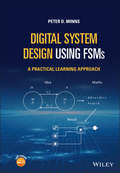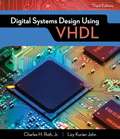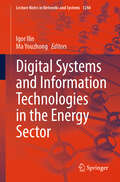- Table View
- List View
Digital Society for the IB Diploma
by Michael Fitzpatrick Eli Bomfim Tammy Earle Carol Hancox Jonathon Levin Barbara StefanicsDeveloped in cooperation with the International Baccalaureate®Ensure full coverage of the new Digital Society course with this accessible coursebook written by an experienced international team of IB educators and examiners, enabling students to build skills and understand the importance and impact of digital systems and technologies in the contemporary world.- Explore digital society through the key concepts, content and contexts of the syllabus with clear, real world, internationally-minded examples for each topic.- Delve into the higher-level extension challenges and interventions in digital society using contemporary,real-world issues that allow students to formulate their own recommendations, with chapter reflections to consolidate learning throughout.- Essential tools for inquiry are integrated throughout the course, with links to ATL, TOK, and extended essay.- Specific chapters and activities are featured for conducting inquiries suitable for SL and HL students, with added extended inquiries for HL students.- Prepare for the inquiry project with step-by-step guidance, advice, practice questions and top tips onhow to maximise potential in the assessment.
Digital Sociology
by Kate Orton-Johnson Nick PriorSociology and our sociological imaginations are having to confront new digital landscapes spanning mediated social relationships, practices and social structures. This volume assesses the substantive challenges faced by the discipline as it critically reassesses its position in the digital age.
Digital Solutions for Environmental and Economic Development: Select Proceedings of ICEIL 2024, Volume 2 (Lecture Notes in Electrical Engineering #1385)
by Sumeet Gupta Balvinder Shukla B. K. Murthy Nitasha Hasteer Diptiranjan MahapatraThe proceedings of 6th International Conference on Entrepreneurship Innovation and Leadership (ICEIL 2024) would focus on Intelligent IT Solutions to promote indigenous innovations. The book will be a catalyst for transformative change, inspiring a collective effort towards harnessing the power of technology for sustainable, self-reliant development. This book will be a compilation of latest technological advancements and state of the art research in the emerging technologies like artificial intelligence, blockchain, internet of things, quantum computing etc. This book will be useful for students, research scholars and practitioners from different disciplines to enhance their knowledge.
Digital Soul: Intelligent Machines and Human Values
by Thomas GeorgesShould the day come when intelligent machines not only make computations but also think and experience emotions as humans do, how will we distinguish the "human” from the "machine”? This introduction to artificial intelligence - and to its potentially profound social, moral, and ethical implications - is designed for readers with little or no technical background. In accessible, focused, engaging discussions, physicist and award-winning science writer Thomas Georges explores the fundamental issues: What is consciousness? Can computers be conscious? If machines could think and even feel, would they then be entitled to "human” rights? Will machines and people merge into a biomechanical race? Should we worry that super-intelligent machines might take over the world? Even now we continue to put increasingly sophisticated machines in control of critical aspects of our lives in ways that may hold unforeseen consequences for the human race. Digital Soul challenges all of us, before it’s too late, to think carefully and rationally about the kind of world we will want to live in - with intelligent machines ever closer by our sides.
Digital Sovereignty in Cyber Security: First International Workshop, CyberSec4Europe 2022, Venice, Italy, April 17–21, 2022, Revised Selected Papers (Communications in Computer and Information Science #1807)
by Antonio Skarmeta Antonio Lioy Daniele Canavese Sara MatheuThis book constitutes papers presented during the workshop session titled “CyberSec4Europe - Research to Innovation: Common Research Framework on Security and Privacy” during the Privacy Symposium hosted by Università Ca’ Foscari in Venice, Italy, in April 2022. The 11 peer-reviewed selected papers present findings, conclusions, research, and recommendations in various security-related areas, from highly technical ones (e.g., software and network security) to law and human-centric ones (e.g., governance and cybersecurity awareness).
Digital Speech Processing Using Matlab
by E. S. GopiDigital Speech Processing Using Matlab deals with digital speech pattern recognition, speech production model, speech feature extraction, and speech compression. The book is written in a manner that is suitable for beginners pursuing basic research in digital speech processing. Matlab illustrations are provided for most topics to enable better understanding of concepts. This book also deals with the basic pattern recognition techniques (illustrated with speech signals using Matlab) such as PCA, LDA, ICA, SVM, HMM, GMM, BPN, and KSOM.
Digital Speech Processing, Synthesis, and Recognition: Synthesis, and Recognition, Second Edition, (Signal Processing and Communications #7)
by Sadaoki FuruiA study of digital speech processing, synthesis and recognition. This second edition contains new sections on the international standardization of robust and flexible speech coding techniques, waveform unit concatenation-based speech synthesis, large vocabulary continuous-speech recognition based on statistical pattern recognition, and more.
Digital State
by Simon PontWhat is the Digital State? What is our Digital State of Mind? What does this Digital State mean for brands and for businesses? Big data, new distribution platforms, content collaboration, geo-targeting, crowdsourcing, viral marketing, mobile apps - the technological revolution has transformed the way society communicates and understands itself, and unleashed a whirlwind of new possibilities for marketers, as well as new risks. Mirroring the 'collaborative play space' Tim Berners-Lee first envisaged for the internet, Digital State brings together Simon Pont and 13 thought-leaders drawn from the worlds of advertising, marketing, media, publishing, law, finance and more, to explore what the digital age means for us as individuals, and the implications for the brands seeking to engage with us. Edited and part-written by Simon Pont, Digital State explores the possibilities and pitfalls of our digital age, an age where people can be brought together and new opportunities explored like never before.
Digital Storage in Consumer Electronics
by Thomas M. CoughlinCan you imagine life without your cell phone, laptop, digital camera, iPod, BlackBerry, flat-screen TV, or DVD player? The skyrocketing demand for devices that provide simple, immediate access to large amounts of content is driving required digital storage capacity to unprecedented levels. Designing digital storage into consumer electronics is crucial to the performance and cost of these devices. However, as our requirements for digital content storage grow, so does the formidable difficulty of implementing design solutions that are rugged, long-lasting, power-miserly, secure, network-accessible and can still fit in the palm of your hand! This book provides the background necessary to understand common digital storage devices and media. It helps readers decide which methods of storage work best for which kinds of devices, and then teaches designers how to successfully integrate them into consumer products. * Presents best practices for selecting, integrating, and using storage devices to achieve higher performance, greater reliability and lower cost * Teardown photos provide rare visuals of the "guts" of the devices discussed * Covers hot topics including flash memory, DVRs, Apple iPods, home networks, and automotive electronics, from basic layouts to standards, advanced features, and exciting growth opportunities
Digital Storytelling
by Shilo T. MccleanComputer-generated effects are often blamed for bad Hollywood movies. Yet when a critic complains that "technology swamps storytelling" (in a review of Van Helsing, calling it "an example of everything that is wrong with Hollywood computer-generated effects movies"), it says more about the weakness of the story than the strength of the technology. In Digital Storytelling, Shilo McClean shows how digital visual effects can be a tool of storytelling in film, adding narrative power as do sound, color, and "experimental" camera angles--other innovative film technologies that were once criticized for being distractions from the story. It is time, she says, to rethink the function of digital visual effects. Effects artists say--contrary to the critics--that effects always derive from story. Digital effects are a part of production, not post-production; they are becoming part of the story development process. Digital Storytelling is grounded in filmmaking, the scriptwriting process in particular. McClean considers crucial questions about digital visual effects-- whether they undermine classical storytelling structure, if they always call attention to themselves, whether their use is limited to certain genres--and looks at contemporary films (including a chapter-long analysis of Steven Spielberg's use of computer-generated effects) and contemporary film theory to find the answers. McClean argues that to consider digital visual effects as simply contributing the "wow" factor underestimates them. They are, she writes, the legitimate inheritors of film storycraft.
Digital Storytelling 4e: A creator's guide to interactive entertainment
by Carolyn Handler MillerThis fourth edition of Digital Storytelling: A creator's guide to interactive entertainment dives deeply into the world of interactive storytelling, a form of storytelling made possible by digital media. Carolyn Handler Miller covers both the basics – character development, structure and the use of interactivity – and the more advanced topics, such as AI (Artificial Intelligence), narratives using AR and VR, and Social Media storytelling. The fourth edition also includes a greatly expanded section on immersive media, with chapters on the exciting new world of the world of XR (AR, VR, and mixed reality), plus immersion via large screens, escape rooms and new kinds of theme park experiences. This edition covers all viable forms of New Media, from video games to interactive documentaries. With numerous case studies that delve into the processes and challenges of developing works of interactive narrative, this new edition illustrates the creative possibilities of digital storytelling. The book goes beyond using digital media for entertainment and covers its employment for education, training, information and promotion, featuring interviews with some of the industry’s biggest names. Key Features: A large new section covering various forms of immersive media, including VR, AR and Mixed Reality Breakthroughs in interactive TV and Cinema The use of VR, AR and mixed reality in gaming New forms of voice-enabled storytelling and gaming Stories told via mobile apps and social media Developing Digital Storytelling for different types of audiences
Digital Storytelling for Educative Purposes: Providing an Evidence-Base for Classroom Practice (Studies in Singapore Education: Research, Innovation & Practice #1)
by Phillip Alexander Towndrow Galyna KogutThis book is an exposition of a curriculum innovation within the complex yet fertile ground of school-based education in Singapore. Beyond straightforward descriptions and protocols, this book purposefully connects classroom practices with theories in a clear, uncomplicated way. The result provides a series of rationales for action, reflection and understanding that other publications in digital storytelling sometimes fail to cover or explain in sufficient detail. Broadly, these include digital multimodal authorship; teachers’ and students’ storytelling task design and assessment; the use of digital storytelling as a reflective and reflexive expression of teachers’ professionalism; and dialogism in classroom practice.
Digital Storytelling: A Creator's Guide to Interactive Entertainment, Volume I
by Carolyn Handler MillerDigital Storytelling: A Creator’s Guide to Interactive Entertainment, Volume I, fifth edition delves into the fascinating and groundbreaking stories enabled by interactive digital media, examining both fictional and non‑fiction narratives. This fifth edition explores monumental developments, particularly the emergence of generative AI, and highlights exciting projects utilizing this technology. Additionally, it covers social media; interactive documentaries; immersive environments; and innovative uses of video games, chatbots, and virtual reality.Carolyn Handler Miller provides insights into storytelling essentials like character development, plot, structure, dialogue, and emotion, while examining how digital media and interactivity influence these elements. This book also dives into advanced topics, such as narratives using AR, VR, and XR, alongside new forms of immersive media, including large screens, escape rooms, and theme park experiences.With numerous case studies, this edition illustrates the creative possibilities of digital storytelling and its applications beyond entertainment, such as education, training, information, and promotion. Interviews with industry leaders further enhance the understanding of this evolving universe, making it a valuable resource for both professionals and enthusiasts.Key Features:• This book includes up-to-the-minute developments in digital storytelling.• It offers case studies of noteworthy examples of digital storytelling.• It includes a glossary clearly defining new or difficult terms.• Each chapter opens with several thought-provoking questions about the chapter’s topic.• Each chapter concludes with several creative and engaging exercises to promote the reader’s understanding of the chapter’s topic.
Digital Storytelling: A creator's guide to interactive entertainment
by Carolyn Handler MillerDigital Storytelling shows you how to create immersive, interactive narratives across a multitude of platforms, devices, and media. From age-old storytelling techniques to cutting-edge development processes, this book covers creating stories for all forms of New Media, including transmedia storytelling, video games, mobile apps, and second screen experiences. The way a story is told, a message is delivered, or a narrative is navigated has changed dramatically over the last few years. Stories are told through video games, interactive books, and social media. Stories are told on all sorts of different platforms and through all sorts of different devices. They’re immersive, letting the user interact with the story and letting the user enter the story and shape it themselves. This book features case studies that cover a great spectrum of platforms and different story genres. It also shows you how to plan processes for developing interactive narratives for all forms of entertainment and non-fiction purposes: education, training, information and promotion. Digital Storytelling features interviews with some of the industry’s biggest names, showing you how they build and tell their stories.
Digital Storytelling: Capturing Lives, Creating Community
by Joe Lambert Brooke HesslerIn this revised and updated edition of the StoryCenter's popular guide to digital storytelling, StoryCenter founder Joe Lambert offers budding storytellers the skills and tools they need to craft compelling digital stories. Using a "Seven Steps" approach, Lambert helps storytellers identify the fundamentals of dynamic digital storytelling – from conceiving a story, to seeing, assembling, and sharing it. Readers will also find new explorations of the global applications of digital storytelling in education and other fields, as well as additional information about copyright, ethics, and distribution. The book is filled with resources about past and present projects on the grassroots and institutional level, including new chapters specifically for students and a discussion of the latest tools and projects in mobile device-based media. This accessible guide’s meaningful examples and inviting tone makes this an essential for any student learning the steps toward digital storytelling.
Digital Stractics: How Strategy Met Tactics And Killed The Strategic Plan
by Chris OutramIn the world of digital business, the line between strategy and tactics is blurring. Traditionally large companies would adopt strategic frameworks which planned over three- to five-year timescales, while most digital start-ups had little interest in comprehensive and rigorous strategic processes and simply set themselves vision and worked out how to get there along the way. In today's digital economy even large companies are finding that their planning horizons are being measured in months rather than years or quarters (if not yet in the weeks or even days of startups). On the other hand, investors are less swayed by the excitement of 'digital' and expect harder and more rigorous medium term planning from start-ups. As a result, while the empirical process of learning by doing is becoming part of traditional companies' strategy processes, digital pure plays are no longer just making it up as they go along, but actively learning and changing as they go along. In short: on the battlefield of online commerce, strategy blends with tactics. Indeed, the distinction between pure play and hybrid is increasingly redundant as more holistic business models begin to emerge. Digital Stractics captures the experience and insights of some 60 entrepreneurs, CEOs and chairmen of both pure plays and hybrids to formulate frameworks within which both pure plays and hybrids can shape their strategy and business models. As timescales between 'plan' and 'do' collapse strategy and tactics have to blend. The world of STRACTICS is upon us.
Digital Strategy and Governance in Transformative Technologies
by Aashish Srivastava Ridoan Karim Arif Perdana S Vijayakumar Bharathi Saru ArifinDigital Strategy and Governance in Transformative Technologies offers a comprehensive exploration of how emerging technologies are reshaping business operations, governance structures, and societal interactions. This timely volume examines the complex interplay between digital strategies and governance frameworks across AI, blockchain, cryptocurrencies, and the metaverse. It provides crucial insights for navigating the digital frontier.The book’s strength lies in its multifaceted approach, moving from foundational concepts to specialized applications. It begins by examining technological convergence challenges and strategic foundations, then delves deep into pressing issues such as AI ethics in healthcare and law enforcement, blockchain’s role in fostering trust and accountability, cryptocurrency regulation, and the legal implications of the metaverse. The authors address critical questions about the ethical deployment of digital technology, blockchain transparency, cryptocurrency governance, and virtual space regulation through detailed case studies and empirical research. What sets this book apart is its balanced treatment of both theoretical frameworks and practical applications. The authors do not just explore technological capabilities; they examine how these innovations intersect with ethical considerations, regulatory compliance, and sustainable practices. From analyzing Meta’s political ad policies to examining e-waste management in the digital era, the book offers actionable insights for policymakers, business leaders, and practitioners.This essential resource serves as a guide for organizations and institutions grappling with digital transformation challenges. Whether you are a technology strategist, policymaker, academic researcher, or business leader, this book provides the framework and insights needed to develop effective digital strategies while ensuring responsible governance in an increasingly complex technological landscape.
Digital Suffragists: Women, the Web, and the Future of Democracy
by Marie TessierWhy women&’s voices are outnumbered online and what we can do about it, by a New York Times comment moderator.If you&’ve read the comments posted by readers of online news sites, you may have noticed the absence of women&’s voices. Men are by far the most prolific commenters on politics and public affairs. When women do comment, they are often attacked or dismissed more than men are. In fact, the comment forums on news sites replicate conditions of the offline and social media worlds, where women are routinely interrupted, threatened, demeaned, and called wrong, unruly, disgusting, and out of place. In Digital Suffragists, Marie Tessier—a veteran journalist and a New York Times comment moderator for more than a decade—investigates why women&’s voices are outnumbered online and what we can do about it. The suffragists of the early twentieth century were jailed for trying to vote. Can a twenty-first century democracy be functional when half of the population is not fully represented in a primary form of political communication? Tessier shows that for online comments, it&’s a design problem: the linear blog comment formula was based on deeply gender-biased assumptions. Technologies designed with a broad range of end users in mind, she points out, are more successful and beneficial than those that reflect the designer&’s own habits of mind. Tessier outlines benchmarks for a more democratic media, all of which stem from one fundamental idea: media must adopt gender and racial representation as key performance indicators. Equal speaking time for women is a measure of democracy.
Digital Supply Chains: Key Facilitator to Industry 4.0 and New Business Models, Leveraging S/4 HANA and Beyond
by Götz G. WehbergThis book provides a practical guide to digital supply chain modelling, demonstrating an agile approach to how such models can be applied to any manufacturing company to build competitive advantage, facilitate new business models and drive towards Industry 4.0. The agile approach of the book provides an attractive alternative to the conventional country-by-country deployment of S/4 HANA and other relevant technologies. This book contains the expertise Gotz G. Wehberg has amassed over 20 years as a senior partner in a leading consulting company, working across industries and with globally recognized clients, advising on digitization. In it, he explains the scientific roots of digital supply chain management such as holism, cybernetics, self-organization and evolutionary theory to inform a deep understanding that can drive a supremely innovative strategy for Industry 4.0. Beyond strategy, Wehberg introduces the practical tools and technologies used in supply chain modelling, for example, sensors, big data, artificial intelligence and the Internet of Things, as well as a reference framework that categorizes the technologies, together with the latest concepts and tools, such as DDMRP, predictive S&OP, pattern recognition, autonomous logistics and Lean. This framework supports decision making for developing supply chains in an end-to-end and cross-functional fashion, providing clear guidance for executives and managers on how to design supply chains for the future.
Digital Synergy
by Ibrahiem M.M. El EmaryIn an era where technological progress redefines the boundaries of business and management, ‘Digital Synergy - Innovative Management in the ICT Era’ emerges as a guide for current and aspiring leaders. This book delves into the heart of modern management practices, illuminated by the transformative power of Information and Communication Technologies (ICT) and digital synergy. Facing the relentless pace of change, adaptation, innovation, and the utilization of digital synergy are no longer optional; they are the bedrock of sustainable success. Through a carefully selected collection of theories, case studies, expert insights, and examples of digital synergy, this book provides the foresight and tools necessary to navigate through the complexities of a globalized, digital marketplace.The book is divided into four sections:1. Financial and strategic management in uncertain times2. Global trends and management challenges3. Corporate social responsibility and effective CSR management4. The future of logistics, with a special focus on military logisticsDesigned for business leaders, managers, students, and anyone keen on deepening their understanding of how ICT and digital synergy shape management strategies, this book is a call to action. It challenges to not just keep pace with technological progress but to lead the charge in leveraging it for strategic advantage.
Digital System Design - Use of Microcontroller: Use Of Microcontroller (River Publishers Series In Signal, Image And Speech Processing Ser.)
by Shenouda Dawoud R. PeplowEmbedded systems are today, widely deployed in just about every piece of machinery from toasters to spacecraft. Embedded system designers face many challenges. They are asked to produce increasingly complex systems using the latest technologies, but these technologies are changing faster than ever. They are asked to produce better quality designs with a shorter time-to-market. They are asked to implement increasingly complex functionality but more importantly to satisfy numerous other constraints. To achieve the current goals of design, the designer must be aware with such design constraints and more importantly, the factors that have a direct effect on them.One of the challenges facing embedded system designers is the selection of the optimum processor for the application in hand; single-purpose, general-purpose or application specific. Microcontrollers are one member of the family of the application specific processors.The book concentrates on the use of microcontroller as the embedded system?s processor, and how to use it in many embedded system applications. The book covers both the hardware and software aspects needed to design using microcontroller.The book is ideal for undergraduate students and also the engineers that are working in the field of digital system design.Contents• Preface;• Process design metrics;• A systems approach to digital system design;• Introduction to microcontrollers and microprocessors;• Instructions and Instruction sets;• Machine language and assembly language;• System memory; Timers, counters and watchdog timer;• Interfacing to local devices / peripherals;• Analogue data and the analogue I/O subsystem;• Multiprocessor communications;• Serial Communications and Network-based interfaces.
Digital System Design using FSMs: A Practical Learning Approach
by Peter D. MinnsThis is a complete update of the author's earlier book, FSM-Based Digital Design using Verilog HDL (Wiley 2008). Whilst the essential foundation content remains, the book has been considerably refreshed to cover the design of Finite State Machines (FSM) in place of Microprocessors, using a novel form of State Machines based on Toggle Flip Flops (TFF) and Data Flip Flops (DFF). It follows a Linear Programmed Learning approach, enabling the reader to learn at their own pace, and to design their own FSM based systems.
Digital Systems Design Using VHDL (Activate Learning With These New Titles From Engineering! Ser.)
by Charles Roth Lizy JohnLearn how to effectively use the industry-standard hardware description language, VHDL, as DIGITAL SYSTEMS DESIGN USING VHDL, 3E integrates VHDL into the digital design process. The book begins with a valuable review of basic logic design concepts before introducing the fundamentals of VHDL. The book concludes with detailed coverage of advanced VHDL topics.
Digital Systems and Applications (Computer Engineering Series)
by Vojin G. OklobdzijaNew design architectures in computer systems have surpassed industry expectations. Limits, which were once thought of as fundamental, have now been broken. Digital Systems and Applications details these innovations in systems design as well as cutting-edge applications that are emerging to take advantage of the fields increasingly sophisticated capabilities. This book features new chapters on parallelizing iterative heuristics, stream and wireless processors, and lightweight embedded systems. This fundamental text— Provides a clear focus on computer systems, architecture, and applications Takes a top-level view of system organization before moving on to architectural and organizational concepts such as superscalar and vector processor, VLIW architecture, as well as new trends in multithreading and multiprocessing. includes an entire section dedicated to embedded systems and their applications Discusses topics such as digital signal processing applications, circuit implementation aspects, parallel I/O algorithms, and operating systems Concludes with a look at new and future directions in computing Features articles that describe diverse aspects of computer usage and potentials for use Details implementation and performance-enhancing techniques such as branch prediction, register renaming, and virtual memory Includes a section on new directions in computing and their penetration into many new fields and aspects of our daily lives
Digital Systems and Information Technologies in the Energy Sector (Lecture Notes in Networks and Systems #1244)
by Igor Ilin Ma YouzhongDigital transformation and energy transition are undoubtedly the key trends of the last decade that are fundamentally changing the way countries, regions and the global community conduct their economic activities. At first glance, these are phenomena of completely different nature. The editors and authors of the book offer a closer look at the specifics of the development of each trend, the nature of their interdependence, analyze the possibilities of coexistence, and determine the potential effects of such technological symbiosis. The book is characterized by an original, interdisciplinary statement of the problem: description of various aspects of effective interaction between elements of energy and information-technology/digital infrastructures that jointly ensure information needs and compliance with energy efficiency requirements of the modern economy. At the same time, attention is paid to each technological trend separately, as well as to the possibilities of interaction between technological capabilities of energy and digital. International author teams of professionals in different fields offer an interesting perspective on certain aspects of modern technological development of various industries. The book will be of interest to both experienced researchers, undergraduate and graduate students, and practitioners, both energy and IT specialists and even mathematicians.
